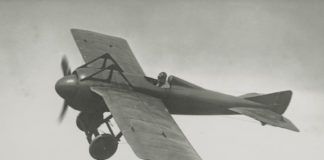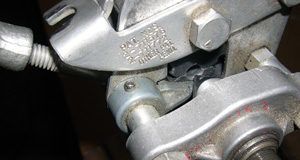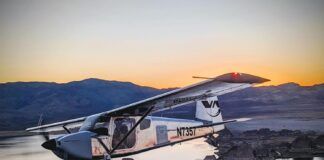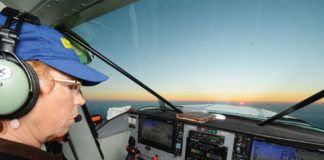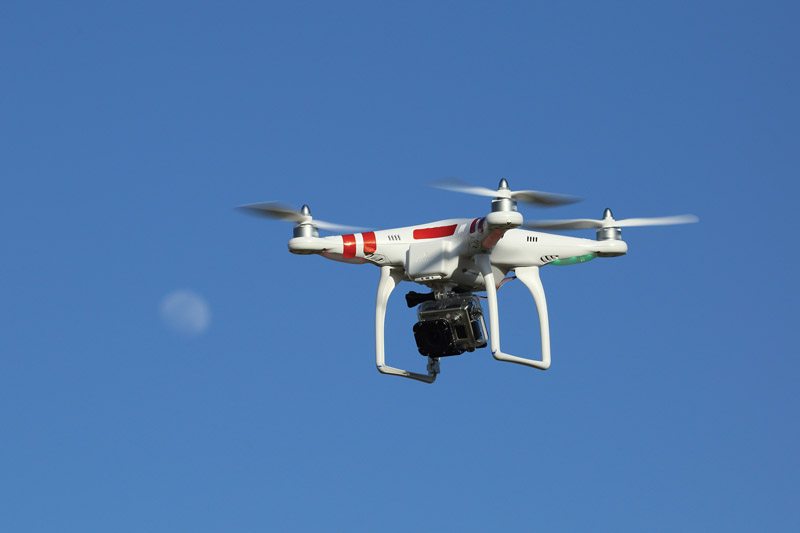
Photo: Don McCullough [CC BY 2.0 (http://creativecommons.org/licenses/by/2.0)], via Wikimedia Commons
When it comes to purchasing a propeller, my imagination conjures an imaginary place, likely a tin shed in an industrial complex at the edge of an airport. It’s none too bright inside and glorified blacksmith implements stand ready next to towering work stands. Racks of constant-speed project props brood over the scene, while a quiet type in a shop apron tends to a three-blade. A dog sleeps in the corner.
So it was a shock to hear my wife’s voice cut through my mental clutter with, “That’s a drone, isn’t it?” We were standing in an Apple store—you know, one of those brightly lit, austerely decorated mall halls cheery with hoards of normal people fiddling with iEverythings. And there, on the shelf in front of me, was one of those sparse white boxes with, yes, a photo of an equally white multi-rotor on it. Next to that was a smaller white box, this one with the outline of a two-blade, fixed-pitch paddle prop on the side.
“Hmmph. You can buy a propeller at the Apple store.”
What a mental ramp check. Props at Apple. And all that buzzing youthful enthusiasm filling the place…this drone and spare props are something they actually buy and fly.
Suddenly my great nightmare—casual aviation for the masses—lay manifest in front of me. The thought of legions of the unwashed buzzing around with the same consideration they drive cars gives me hives, and while the explosion in light UAVs hadn’t gone by unnoticed, seeing props at the Apple store really reset my reality meter.
Turns out while I had my head hid in a cowling regarding UAV news, the Feds have already gifted the lawyers with an entirely new FAR Part 107 playground for all things UAV. Accordingly, recreational UAV operators flying tiny whiz bits are pretty much free to play below 400 feet, and electronic “geofencing” holds some promise for keeping junior’s multi-rotor out of my flying wires at 2500 feet.
Commercial UAV operations are allowed using craft weighing less than 55 pounds, and the pilot in command must hold a Remote Pilot Certificate. There are some sensible limits and conditions about operating around towered airports and notifying ATC; one hopes everyone plays by the rules, as who knows how enforceable all this will be, and the forecast is RPC license holders will outnumber Private Pilots in two years.
Presumably a combination of GPS magic and ADS-B watchdogging will give commercial types the desired fear of punishment to make this work. On the other hand, am I the only one horrified by the Big Brotherism of ADS-B? For all the breathlessness over the latest weather reports piped into the cockpit, there’s no way I can agree with anyone’s need to know the precise identity of a pilot or aircraft, especially the gov’mnt. Besides, I’m sitting outside in my Starduster Too and already know it’s cold up there.
But back to UAVs. Now that they’re here and supposedly soon to blot out the sun with their numbers, what are the ramifications for sport aviation as we know it?
After considerable thought (two beers), the likely answer is, “not much.”
Well, not much if your yardstick is converting UAV operators into aviators—can you see an EAA Drone Eagles initiative? Certainly it’s possible to realize a wholesale gain from aviation’s greatest gift: to look down and realize how petty our daily lives are and how grand nature remains. Is it really necessary for the body to be up there to sense the force of nature, or is camera-born imagination enough? Likely the latter when it comes to broadening horizons, and like international travel, that’s a wonderful thing.
Classic model airplane building was once the gateway hobby to a Private Pilot license; will two-thumbing a UAV foster a need to wrap a fist around a stick? In a few cases, no doubt, but more often my guess is the average drone pilot won’t really care to drag his carcass aloft.
For one thing, a UAV pilot is already “aloft,” at least from a vision standpoint, so unlike a traditional model builder, a UAV operator might already consider himself a pilot. The Air Force sort of does. Paying hugely in time and money for flying privileges doesn’t gain a UAV driver the same as a model builder.
Secondly, what a model builder builds resembles a conventional piloted aircraft, often all the way down to a pilot figure for the imagination to anchor on to. The model builder is emulating manned flight and to great extent benchmarks his hobby thusly. UAV operators have no such connection; theirs is a new kind of craft, conceived from the beginning as “pilotless.” Video gamers likely have as much kinship with aviation.
Thirdly, many a UAV stud is just doing a job. If checking power line insulators with a drone means not having to sway up there in a lift bucket, that guy probably sees drones as a great way of keeping his feet on the ground, not getting them up in the air.
Finally, becoming a pilot takes commitment, droning hardly so much. As we often lament the lack of young people around the airport, the usual (valid) financial reasons are given. But just as large is the difficulty and time involved in joining manned flight. Today there’s always something new to try, so hobbies are sampled and discarded indifferently. But learning to fly takes a lifetime if done right. It’s at least a year of weekly sweat sessions in a cockpit cramped by a living, resuscitating instructor (this by a generation afraid to make a phone call in lieu of texting), and there’s noise, danger, and pollution involved. Yuck!
Ironically, where kit aircraft flying and droning Venn together is electronically—ironic because the foundation of all those glass panels and black boxes we’re putting in our RVs and GlaStars is to remove the pilot from flying. Draw a wind triangle? You’re kidding. The GPS tells all. Feel the wing wash over the elevators through the stick? Not while your attention is focused on an angle-of-attack indicator. Guesstimate how long to fuel exhaustion? Nope, got that down to the minute and corrected for the wind right here on the EFIS. Know how to start a hot injected engine? Can’t; the computer does it (or will soon).
We don’t really believe an 18-year-old UAV driver is going to be impressed by learning a carbureted O-200 needs priming on a cold morning do we? He’ll walk away laughing at all those old farts playing with their antique airplanes.
Just the same, if finding a quadcopter under the Christmas tree isn’t a welcome mat to the left seat of a Cessna 150, it can’t hurt that millions will at least look upward and perchance wonder. Our job is to welcome as many of them as possible. Drone Eagles, indeed.

![]()
Tom Wilson
Pumping avgas and waxing flight school airplanes got Tom into general aviation in 1973, but the lure of racing cars and motorcycles sent him down a motor journalism career heavy on engines and racing. Today he still writes for peanuts and flies for fun.










